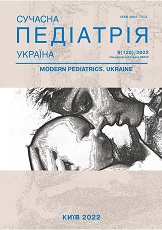A rare disorder of blood coagulation
DOI:
https://doi.org/10.15574/SP.2022.126.97Keywords:
blood coagulation factor, rare coagulopathy, homozygotes, hemorrhagic syndrome, bleedingAbstract
The problem of impaired hemostasis remains relevant even today. Rare bleeding disorders that cause life-threatening bleeding in patient are often overlooked by clinicians.
Rare blood coagulation disorders are a genetically determined group of coagulopathies caused by a deficiency of blood plasma proteins involved in hemostasis, as well as a deficiency of fibrinogen, prothrombin, blood coagulation factor V (FV), blood coagulation factors V and VIII (FV+FVIII), blood coagulation factor VII (FVII), blood coagulation factor X (FX), blood coagulation factor XI (FXI), blood coagulation factor XII (FXII), blood coagulation factor XIII (FXIII), which are clinically are manifested by bleeding. The amount of the factor determines not only the nature of bleeding, but also their severity and prognosis for the disease.
In such patients, the general hemostatic balance is important, since the level of each blood coagulation factor and the general control of hemostasis, which can determine the risk of bleeding, remain important.
Purpose - to draw the attention of doctors of various specialties to the problem of clinical manifestations of rare hereditary disorders of blood coagulation, which can be accompanied by bleeding that poses a threat to the health and life of patient.
Clinical case. A clinical case is presented that illustrates the course of a rare blood coagulation disorder in children from one family, where a comprehensive diagnostic search was conducted by doctors of various specialties to establish a final diagnosis.
Conclusions. Rare blood coagulation disorders are a pathology that is not often found in the population, but clinical symptoms can have negative consequences for a person's health and life. Children with various manifestations of hemorrhagic syndrome need a thorough diagnostic examination in specialized laboratories. Physicians of related specialties should look for a possible rare deficiency of the coagulation factor in early and late complications in the postoperative period or after medical manipulations. It is necessary to remember the hereditary genesis of this pathology and examine all family members.
The research was carried out in accordance with the principles of the Helsinki Declaration. The informed consent of the patient was obtained for conducting the studies.
No conflict of interests was declared by the authors.
References
Europen Haemophilia consortium. (2014). Extremely Rare Bleeding Disorders. URL: https://www.ehc.eu/bleeding-disorders/rare-bleeding-disorders/.
Franchini M, Marano G, Pupella S. (2018, Sep). Rare congenital bleeding disorders. Annals of Translational Medicine. 6: 17. https://doi.org/10.21037/atm.2018.08.34; PMid:30306070 PMCid:PMC6174186
Hartung H. (2018). Pediatric Factor VII Deficiency. Accessed March 5. URL: https://rarediseases.org/rare-diseases/factor-vii-deficiency/.
ICH GCP. (2019). Cross-section study on prevalence of coagulstion factors deficiency in Assiut University Children Hospital. URL: https://ichgcp.net/clinical-trials-registry/NCT03273998.
Mahmood R, Mahmood A, Khan M et al. (2020). Rare bleeding disorders: spectrum of disease and clinical manifestations in the Pakistani population. Blood Res. 55 (3): 146-150. https://doi.org/10.5045/br.2020.2020035; PMid:32883892 PMCid:PMC7536560
Menegatti M, Pegvandi F. (2019). Treatment of rare factor deficiencies than hemophilia. Blood. 133 (5): 415-424. https://doi.org/10.1182/blood-2018-06-820738; PMid:30559262
Moake JL, Baylor College of Medicine. (2021). Uncommon Hereditary Coagulation Disorders. URL: https://www.msdmanuals.com/professional/hematology-and-oncology/coagulation-disorders/uncommon-hereditary-coagulation-disorders.
World Federation of Hemophilia. (2009). What are rare clotting factor deficiencies? URL: https://www1.wfh.org/publication/files/pdf-1337.pdf.
Downloads
Published
Issue
Section
License
Copyright (c) 2022 Modern pediatrics. Ukraine

This work is licensed under a Creative Commons Attribution-NonCommercial 4.0 International License.
The policy of the Journal “MODERN PEDIATRICS. UKRAINE” is compatible with the vast majority of funders' of open access and self-archiving policies. The journal provides immediate open access route being convinced that everyone – not only scientists - can benefit from research results, and publishes articles exclusively under open access distribution, with a Creative Commons Attribution-Noncommercial 4.0 international license (СС BY-NC).
Authors transfer the copyright to the Journal “MODERN PEDIATRICS. UKRAINE” when the manuscript is accepted for publication. Authors declare that this manuscript has not been published nor is under simultaneous consideration for publication elsewhere. After publication, the articles become freely available on-line to the public.
Readers have the right to use, distribute, and reproduce articles in any medium, provided the articles and the journal are properly cited.
The use of published materials for commercial purposes is strongly prohibited.

